In the ultra-competitive machining sector, the investment levels required to meet cost and quality demands are not for the faint-hearted
The automotive supply chain is investing heavily to retain and attract new machining contracts for OEM customers as the trend towards outsourcing continues. Companies in Europe and North America are deploying new technologies and machining strategies to fend off competition from the Far East.
A real-world example of how companies can do this is CNC Speedwell, a UK-based subcontractor and part of the Castings Group. Combining investment and production engineering prowess, the company is managing to compete with rivals the world over. With a turnover of only £130,000 (US$260,000) in 1990, the company now grosses approximately £15 million (US$30 million) annually, representing year-on-year growth of about 30 per cent. It machines between 300 and 400 tonnes of SG iron castings each week and has invested almost £20 million (US$ 40million) in new machining technology in the past decade alone.
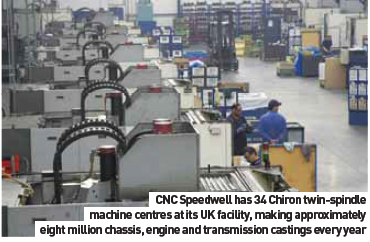
Competitiveness is key
Its core business is the machining of approximately eight million chassis, engine and transmission castings every year. End users include Scania, DAF, Volvo, BMW, Land Rover and nine Toyota plants across the world. The company supplies about 4,500 parts per week to the recently opened Toyota plant in Poland. How does it manage to supply Poland? “Because we are competitive,” says Mark Lewis, CNC Speedwell’s managing director. This entails more than simply applying the right mindset – it requires investment. In 2001, the company bought its first Chiron CNC machining centre from the Engineering Technology Group. Today it has 34 of these models, thirty of which are twinspindle machining centres, largely DZ15 and DZ18 models.
Traditionally, many automotive machining shops shy away from twin-spindle technology, considering the machines overly complex and the arrangement making it difficult to achieve the required levels of accuracy from both spindles. This though has never been an issue at CNC Speedwell, where tolerances in the realm of 0.012-0.017mm are commonplace, along with surface finishes of 1.6Ra. “The two spindles operate simultaneously to produce twice the number of machined parts per cycle,” explains Lewis. “Because non-machining time per component is effectively halved, a twin-spindle machine can give 75 per cent more capacity than an equivalent single-spindle machine.” Each Chiron machine produces between 15,000 to 20,000 parts a year, based on average cycle times and has an integrated two-station workpiece-changing swivel table, with each station incorporating a fourth CNC rotary axis featuring a 900mm bridge to hold the tool plate. Further investments include the company’s first five-axis machining centre – a Chiron M800 – due for integration into a robot-loading cell. The cell will produce gearshift forks containing two sets of compound angles in volumes of approximately 1,200 a week. While CNC Speedwell makes ductile, malleable and grey iron castings (including SiMo and ADI), the machining of compacted graphite iron (CGI) requires a totally different set of manufacturing processes. One specialist is Heller Machine Tools, which was the turnkey supplier of a recent production system designed to machine CGI components for the MAN D20 six-cylinder diesel engine at the heavy duty vehicle maker’s Nuremburg site in Germany.
The rise of CGI
Although automotive metallurgists have been aware of CGI for many years, it has only recently attracted attention. Used for engine blocks and heads, CGI’s advantages include more power and longer intervals between machine maintenance; reduced weight, less pollution and diminished noise. The manufacturing system combines four dedicated machine lines to provide specific machining of critical features, with 18 direct-load MCH 400 horizontal machining centres, providing greater productivity, faster chip-to-chip times, larger axes and greater tool capacity. Pre-machining the main features of the crankcase using CGI 450 includes machining the cylinder head and sump joint faces, as well as the cylinder bores. These are all completed on two of the dedicated machining lines. Singlespindle machining with automatic tool changers and turret heads are deployed at individual stations.
The system also comprises deep-hole drilling and premachining of the crankshaft bore. A special feature of the system is a TBT-gun drilling unit and head changer in the third dedicated machine line. The final section in the manufacturing line is used for finish machining of numerous sealing faces, the crankshaft and cylinder bores, and the cylinder head joint face. In addition to developing and installing the manufacturing system for the D20 crankcases, Heller also planned and commissioned the manufacturing process for other key engine components. The cylinder head is manufactured using 10 Heller MCP-H 400 HMCs and four HCS 400 head changers, integrated into an automated line, while the latest generation of the company’s internal milling machines is used for crankshaft machining.
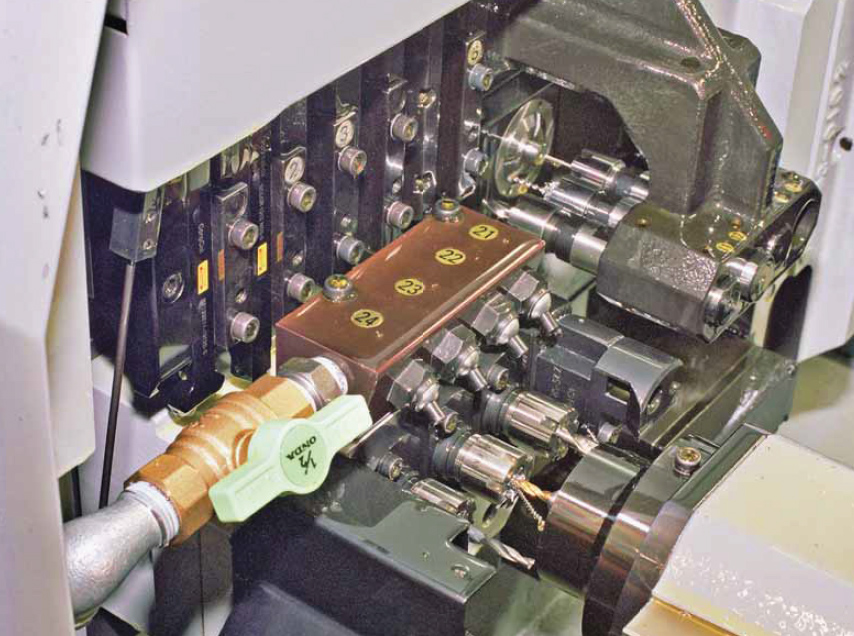
With an in-depth understanding of both transfer line and machining centre technologies, Heller says that conventional technology can no longer meet the requirements of vehicle makers. The trusted transfer line does not have the versatility to make components that are similar (but not the same) at the required cost, nor can it deliver the timeto- market necessary for today’s fickle customers. Today’s machining centres cannot deliver the volumes required in any manageable or cost-effective way.
Versatility in production
Following a meticulous analysis of the production process, Heller introduced the MLS ModuleLineSystem, a new tool combining the flexibility of the machining centre with the volume production of the transfer line. MLS is a networked and fully-integrated system, composed of flexible machines linked in an almost infinitely variable pattern to give versatility in production as well as speed, plentiful process redundancy, minimal piece part cost, minimal lifetime cost and extended longevity.
In a standard operating environment, a series of machine modules are linked by a central tool and parts handling management system to allow components and tooling to pass through the system in the most efficient manner. Further proof of CGI’s growing popularity in the automotive sector is the installation of a system by Scania in Sweden for production of its new cylinder heads and blocks. The truck maker introduced two new machining lines to rough and semi-machine the parts for the revised version of its flagship 15.6 litre, V8 diesel engine.
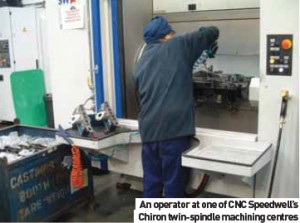 Only Fanuc GE Series 31i-A CNCs will be used on the two machining lines, to be supplied in 2008/09 by Germany’s MAG Powertrain Group. The Fanuc GE CNCs will use a production HMI called ‘Fanuc Auto HMI-NC’, negating the need for PCs at the front-end, together with the associated pitfalls of platform instability, viruses and software lifecycles. Custom built, these HMIs are designed to simplify production monitoring and operation in an automotive environment, making it easy for operators to move between machines and facilitate the management of production and machine maintenance. The MAN and Scania projects are examples of machining strategies paying dividends, but machining operations can also be optimised at a metalcutting level, providing genuine benefits in productivity and quality.
Only Fanuc GE Series 31i-A CNCs will be used on the two machining lines, to be supplied in 2008/09 by Germany’s MAG Powertrain Group. The Fanuc GE CNCs will use a production HMI called ‘Fanuc Auto HMI-NC’, negating the need for PCs at the front-end, together with the associated pitfalls of platform instability, viruses and software lifecycles. Custom built, these HMIs are designed to simplify production monitoring and operation in an automotive environment, making it easy for operators to move between machines and facilitate the management of production and machine maintenance. The MAN and Scania projects are examples of machining strategies paying dividends, but machining operations can also be optimised at a metalcutting level, providing genuine benefits in productivity and quality.
Eliminating filtration problems
In the engineering division at Honda’s Swindon, UK plant, a purpose-built boring and reaming machine is used to machine engine valve seats. Company engineers soon realised that micro particles of metal carried away in the machine’s coolant could adversely affect the critical surface finish of the machined valve seat, which in turn could dramatically impair the efficiency of the engine. Mindful of the Honda hallmark for quality, Peter Jones, who is responsible for the process, considered various filtration options that would help to eliminate this problem. The solution was Eclipse Magnetic’s Micromag, which employs magnetic forces to remove ferrous and paramagnetic particles from fluids such as cutting oils and re-circulating coolants.
“Since incorporating Micromag in our processes, we have ave found that not only does it remove potentially harmful metal particles, but the unit’s maintenance friendly characteristics ensure that we now have minimum machine downtime compared to when we used another filtration system,” he adds.
Machining steel is not all about prismatic operations, however. Turned parts from progressive, investment orientated Tier Two- and Three suppliers are still in high demand, even in western economies such as the UK. Wilco Manufacturing, based in Birmingham in the UK, specialises in the subcontract machining of precision turned parts for the automotive sector in batches of between 500 and 500,000 units. To help produce such a range of quantities, the company has supplemented its single and multi-spindle cam automatics, sprints and fixed-head CNC lathes with three SR-20RII sliding headstock multi-axis turning centres from Star Micronics.
 Cutting down machining time
Cutting down machining time
An example of where considerable improvement in productivity has been made using these machines is the manufacture of a hexagonal automotive steel connector. Whereas in the past Wilco machined the part in four successive operations on a single-spindle automatic, a magazine-loaded auto and a drilling machine, followed by manual deburring, the same component is now machined in just one automatic cycle, halving the original cycle time of 95 seconds. Furthermore, the absence of inter-operation handling has eliminated potential component damage. A similar success story is that of Witon Engineering, of Barnstaple, UK. The company operates four Germanbuilt Index CNC multi-spindle automatics and 30 singlespindle, fixed- and sliding head lathes. One of Witon Engineering’s specialties is machining ferrous automotive components up to 60mm in diameter, with the work being completed by four Index G200 twin-opposed, singlespindle turning machines, three of which are fitted with high-pressure coolant delivery to increase efficiency to machine stainless steel and when the cutting cycles include deep-hole drilling.
The most recently acquired Index machine, an MS52C acquired from UK agent Geo Kingsbury Machine Tools, was brought in to improve machining times of larger parts. Witon has been contracted to machine a 45mm diameter stainless steel component for an automotive customer since 2005, and each part requires a 50-second cycle on the G200s at a rate of 40,000 per month. While not using driven tooling, the process involves removing about 75 per cent of the bar volume by boring and turning a stepped bush, making it a job for a high-power machine. Moved to the MS52C, the cycle time is just 16 seconds.
Saving pays for new investment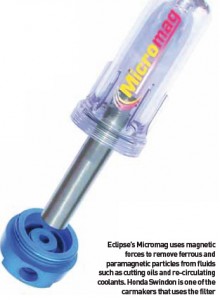
The efficient turning of steel is one thing, but automating the process moves it to a whole new level of productivity, as global Tier One supplier GKN Driveline can testify. For the manufacture of propshafts for the Land Rover Discovery 3 and Range Rover Sport, the Walsall, UK plant of GKN Driveline now features two automated turning cells. Each comprises a pair of Mazak CNC turning centres, loaded and unloaded by a Motoman articulated-arm robot, plus conveyors and handling equipment.
Replacing two operators working round the clock in shifts, the use of the robots (with one operator in attendance) results in a saving sufficient to pay for the capital cost of the robots and their integration. Production is at 14,000 stub shafts per week in the two cells, which are the first lathes on the site to use stand-alone robots; all machining on the CK45 medium carbon steel billets is rotational, with machined components subsequently routed first to spline rolling, carrying on to induction hardening without any manual intervention.
Automotive shafts are not all machined using turning operations. Grinding processes on components such as camshafts should not be overlooked when it comes to machining process reviews, with an investment in capital equipment not always required. Ford Motor Company has recently increased camshaft production by 40 per cent to 1.4 million units a year at its Bridgend plant in the UK, but has not had to invest in extra machinery.
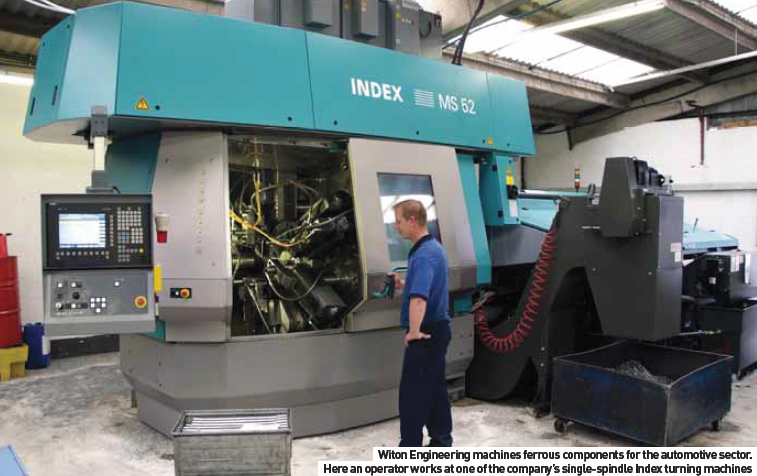 Very much proponents of lean engineering, Ford’s engineers undertook a detailed plant analysis and identified cam lobe grinding as one area where improvements could be made. The process is complex, so Ford called on Tyrolit, its long-term grinding wheel supplier, to recommend how to increase throughput and at the same time, improve the quality and accuracy of the cam surfaces.
Very much proponents of lean engineering, Ford’s engineers undertook a detailed plant analysis and identified cam lobe grinding as one area where improvements could be made. The process is complex, so Ford called on Tyrolit, its long-term grinding wheel supplier, to recommend how to increase throughput and at the same time, improve the quality and accuracy of the cam surfaces.
As part of its consultative approach, Tyrolit formed a working party with Ford engineers to define the project targets and collect data on the existing process for analysis. Following this, the supplier submitted a detailed cost reduction plan in which savings were broken down into cuts in consumables, set-up and machining costs. As a result, floor-to-floor time was reduced from 124 to 112 seconds and the increase in grinding machine capacity was improved by more than 12 per cent, allowing the increase in production without the need for a new plant.
The process of reducing weight
Central to achieving the optimisation targets is the adoption of a newly-developed Tyrolit CBN grinding wheel which draws less spindle power owing to its 60 per cent weight reduction when compared to conventional products. Additionally, the new tool is better able to absorb vibration, allowing a harder bond to be used.
Together with improved dressing, it results in longer wheel life, leading to a significant reduction in cost per part. Overall, the saving in cam lobe grinding has been calculated at over £300,000 (US$600,000) a year over the lifetime of the project.
 With 75 per cent of its output destined for machining operations in the automotive sector, Heller Machine Tools is a global authority on cutting steel. Geoff Lloyd, MD in the UK, who is also president of the Manufacturing Technologies Association (MTA), says, “Engines and automotive components are now required in far more variants of basic design than a decade ago, which means that the manufacturing methods and processes have also changed,” he tells AMS.
With 75 per cent of its output destined for machining operations in the automotive sector, Heller Machine Tools is a global authority on cutting steel. Geoff Lloyd, MD in the UK, who is also president of the Manufacturing Technologies Association (MTA), says, “Engines and automotive components are now required in far more variants of basic design than a decade ago, which means that the manufacturing methods and processes have also changed,” he tells AMS.
He adds that there are three trends infl uencing machining strategy: shorter time to market, more frequent design changes and the need to minimise cost and risk. “For these reasons, manufacturing methods and processes need to be readily adaptable to maximise the period over which the capital investment can be amortised. The machining strategy must embody process security, minimum maintenance requirements, maximum versatility and demonstrate the ability to be modified if design changes arise. “In the light of these considerations, the transfer line is now generally deemed an inappropriate machining method, providing high volumes of identical parts but incapable of easy modification, ramp-up or ramp-down,” he continues. “It also has the inherent disadvantage that, should one station fail, the entire line ceases production. A further disadvantage is that component design must be finalised before a line can be built, giving an unacceptably long product time-to-market for today’s automotive requirements. Cellular manufacture is therefore the preferred option for most vehicle makers.”
So why are horizontal, rather than vertical machining centres the general prerequisite for these manufacturing cells? “The former are considered the most appropriate and cost-effective machines for automotive applications. They offer offer multi-sided machining, easy access for component loading, free fall of swarf so there is no interference with the component and because critical features can be machined in a single set-up, this gives assured compliance with even tight tolerance requirements. Machines equipped with A and B axes enable effective fi ve-sided machining. For example, using a horizontal machining centre, a cylinder head can be fully machined in no more than four – commonly three – set-ups.”
As part of the range, Heller also offers three machines for crankshaft production – internal and external milling machines and the DRZ turn-chasing machine. The latter machine for turn-chasing enables difficult features on all concentric diameters to be machined, such as mains, in-gear diameters, undercuts, grooves and stub ends.
Dry machining is on the increase Another automotive trend identified by Heller is the move towards dry machining. “Many major OEMs are now committing to dry machining programmes,” says Lloyd. “This is because of the considerable cost savings achieved by virtually eliminating the cost of coolant, as well as the cost of disposal and the nuisance of limiting the environmental impact of wet machining. The requirement for dry machining, obviously, drives machine design because a wet machine cannot simply be adapted for dry machining.
The new H Series machines from Heller have been developed specifically with dry machining as an option and exhibit characteristics such as extended swarf free fall for easy chip evacuation as there is no coolant to wash it away. Dry machining is particularly appropriate for components such as gearbox housings and cylinder heads where the material lends itself to these conditions. “We also offer support for cost-down programmes,” adds Lloyd. “Automotive customers expect a saving of at least 10 per cent to be achieved, and once an order has been placed with a machine tool builder, the supplier must demonstrate how costs can be reduced, for instance through optimised axes.”
Heller has recently installed manufacturing processes for all major engine and transmission parts, including heads and blocks for both in-line and V-engines. The level of business that the company achieves across the automotive sector is such that the work justifies specialist, individual departments for each area, for instance large engines, passenger car engines, transmissions, axles, suspension units and crankshafts.


































